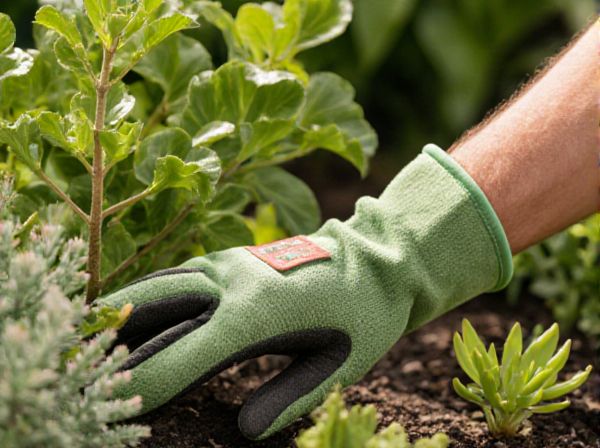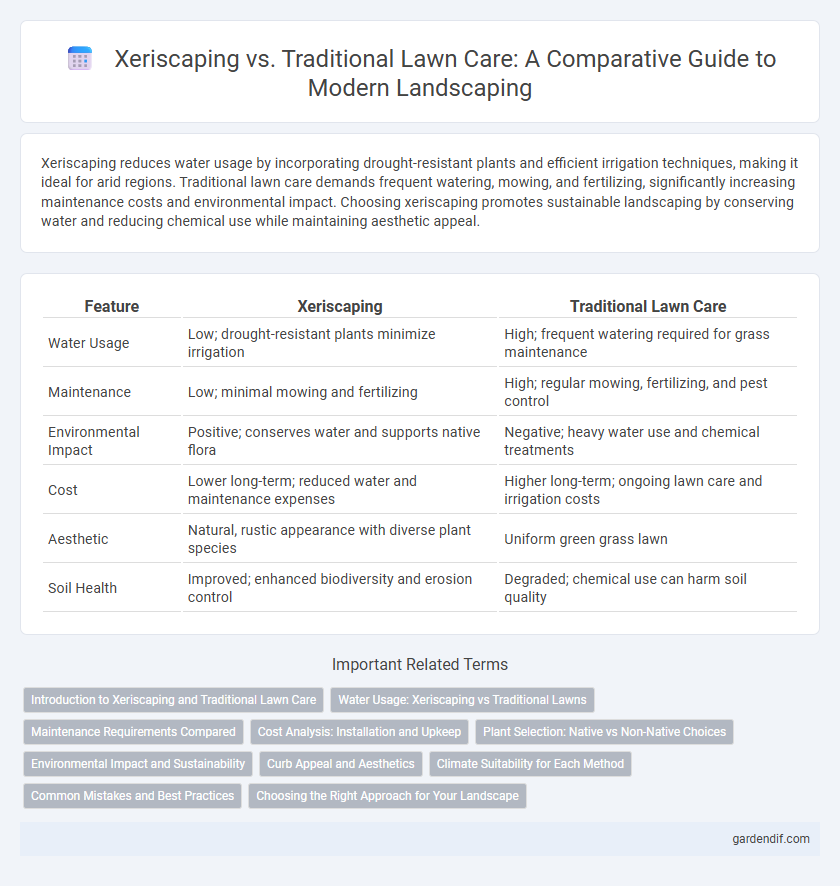
Xeriscaping vs Traditional Lawn Care Illustration
Xeriscaping reduces water usage by incorporating drought-resistant plants and efficient irrigation techniques, making it ideal for arid regions. Traditional lawn care demands frequent watering, mowing, and fertilizing, significantly increasing maintenance costs and environmental impact. Choosing xeriscaping promotes sustainable landscaping by conserving water and reducing chemical use while maintaining aesthetic appeal.
Table of Comparison
| Feature | Xeriscaping | Traditional Lawn Care |
|---|---|---|
| Water Usage | Low; drought-resistant plants minimize irrigation | High; frequent watering required for grass maintenance |
| Maintenance | Low; minimal mowing and fertilizing | High; regular mowing, fertilizing, and pest control |
| Environmental Impact | Positive; conserves water and supports native flora | Negative; heavy water use and chemical treatments |
| Cost | Lower long-term; reduced water and maintenance expenses | Higher long-term; ongoing lawn care and irrigation costs |
| Aesthetic | Natural, rustic appearance with diverse plant species | Uniform green grass lawn |
| Soil Health | Improved; enhanced biodiversity and erosion control | Degraded; chemical use can harm soil quality |
Introduction to Xeriscaping and Traditional Lawn Care
Xeriscaping is a sustainable landscaping method that emphasizes water conservation through drought-tolerant plants, efficient irrigation, and soil improvement, ideal for arid climates. Traditional lawn care involves regular watering, mowing, fertilizing, and pest control to maintain a lush, green turf, often requiring significant water and chemical inputs. Choosing xeriscaping reduces water consumption by up to 50-75% compared to conventional lawn maintenance, while supporting native biodiversity and minimizing environmental impact.
Water Usage: Xeriscaping vs Traditional Lawns
Xeriscaping significantly reduces water usage by utilizing drought-tolerant plants and efficient irrigation methods, consuming up to 50-75% less water than traditional lawns. Traditional lawn care requires frequent watering to maintain lush, green grass, often leading to excessive water consumption and higher utility costs. Implementing xeriscaping supports sustainable landscaping by conserving water resources and lowering environmental impact.
Maintenance Requirements Compared
Xeriscaping drastically reduces water usage by incorporating drought-tolerant plants, eliminating the need for frequent irrigation common in traditional lawn care. Maintenance tasks such as mowing, fertilizing, and pest control are significantly minimized in xeriscaping compared to the regular upkeep required for maintaining lush, grassy lawns. This sustainable landscaping approach lowers both labor and resource costs while promoting environmental resilience.
Cost Analysis: Installation and Upkeep
Xeriscaping reduces installation costs by utilizing drought-tolerant plants that require less soil preparation and fewer irrigation systems compared to traditional lawns. Maintenance expenses drop significantly due to decreased water use, minimal fertilizer, and fewer mowing requirements. Over time, xeriscaping proves more cost-effective by lowering both utility bills and routine upkeep costs associated with conventional lawns.
Plant Selection: Native vs Non-Native Choices
Xeriscaping emphasizes native plant selection, leveraging drought-tolerant species adapted to local climates, which reduces water usage and maintenance. Traditional lawn care often relies on non-native grasses requiring frequent watering, fertilization, and pesticide application for optimal growth. Choosing native plants promotes biodiversity and soil health, whereas non-native choices can lead to increased resource consumption and potential ecosystem disruption.
Environmental Impact and Sustainability
Xeriscaping significantly reduces water consumption by utilizing drought-tolerant plants and minimizing turf grass, which typically requires extensive irrigation and chemical inputs. Traditional lawn care often involves high water usage, fertilizers, and pesticides that contribute to runoff pollution and increased greenhouse gas emissions. Emphasizing native vegetation and efficient irrigation, xeriscaping promotes soil health, biodiversity, and long-term sustainability in landscape management.
Curb Appeal and Aesthetics
Xeriscaping enhances curb appeal by incorporating drought-resistant plants and natural textures that create visually striking, low-maintenance landscapes, while traditional lawn care emphasizes lush, green grass that demands frequent watering and upkeep. Xeriscaped yards often feature diversified color palettes and organic shapes, offering year-round interest and sustainability, contrasting with the uniform appearance of conventional lawns. Integrating xeriscaping can increase property value by appealing to eco-conscious buyers seeking attractive, water-efficient outdoor spaces.
Climate Suitability for Each Method
Xeriscaping is highly suitable for arid and drought-prone climates, utilizing native and drought-resistant plants to conserve water and reduce maintenance. Traditional lawn care thrives in regions with moderate to high rainfall, supporting lush, water-intensive grass that requires regular irrigation and upkeep. Choosing the appropriate method based on local climate optimizes landscape health and resource efficiency.
Common Mistakes and Best Practices
Xeriscaping often faces common mistakes such as overwatering plants that are drought-tolerant and relying on inappropriate plant selection, leading to poor landscape performance. Best practices include choosing native, low-water plants and using efficient irrigation systems like drip irrigation to conserve water. In traditional lawn care, frequent mowing, excessive fertilization, and improper watering are frequent errors that harm grass health and increase maintenance costs.
Choosing the Right Approach for Your Landscape
Xeriscaping conserves water by using drought-tolerant plants and efficient irrigation, making it ideal for arid regions and sustainable landscaping. Traditional lawn care involves regular watering, mowing, and fertilizing to maintain lush turf, suitable for climates with ample rainfall and homeowner preference for green lawns. Evaluating local climate, soil type, water availability, and maintenance capacity helps determine the optimal landscape approach.
Xeriscaping vs Traditional Lawn Care Infographic

 gardendif.com
gardendif.com